Easy Ghee Mysore Pak (Pressure Cooker Method) by DK on Sep 8, 2018

[Update (27 Aug 2020): The OPOS methods are now updated with more stringent rules and methodology. The roux method used in the older version has now been discarded with using roasted besan flour because the roasting is an additional step that goes against its principles. Hence I am legally not permitted to call this OPOS recipe henceforth.]
Has it ever happened that you watched Micheal Phelps swimming or a Usain Bolt running like sheer poetry and believed you can do that as well? Your over enthusiastic adrenaline motivates you to do the same only that Usain bolt would run like he does while you probably would do a phoebe!! You are like - hey waitttaminute! What went wrong? Why is this even difficult? Then somewhere a voice (your conscious of course - who else) gives you gyan that you were deceived/mislead by virtuoso in motion that comes with repeated practice. This South Indian gift to mankind - Ghee Mysore Pak, an immensely smooth "melt-in-the-mouth" sweet, follows the exact same principle. Its a very simple fudge made using chickpea flour (besan) boasting minimalistic ingredients (just 3!!) and quick cooking time. In the world of complicated Indian desserts, this one is supposedly simpler. Ha, did you notice "supposedly"? But never fret! We just found a solution that opens the gate to "sweet" gluttony. You noticed my play on words din't you?
Has it ever happened that you watched Micheal Phelps swimming or a Usain Bolt running like sheer poetry and believed you can do that as well? Your over enthusiastic adrenaline motivates you to do the same only that Usain bolt would run like he does while you probably would do a phoebe!! You are like - hey waitttaminute! What went wrong? Why is this even difficult? Then somewhere a voice (your conscious of course - who else) gives you gyan that you were deceived/mislead by virtuoso in motion that comes with repeated practice. This South Indian gift to mankind - Ghee Mysore Pak, an immensely smooth "melt-in-the-mouth" sweet, follows the exact same principle. Its a very simple fudge made using chickpea flour (besan) boasting minimalistic ingredients (just 3!!) and quick cooking time. In the world of complicated Indian desserts, this one is supposedly simpler. Ha, did you notice "supposedly"? But never fret! We just found a solution that opens the gate to "sweet" gluttony. You noticed my play on words din't you?
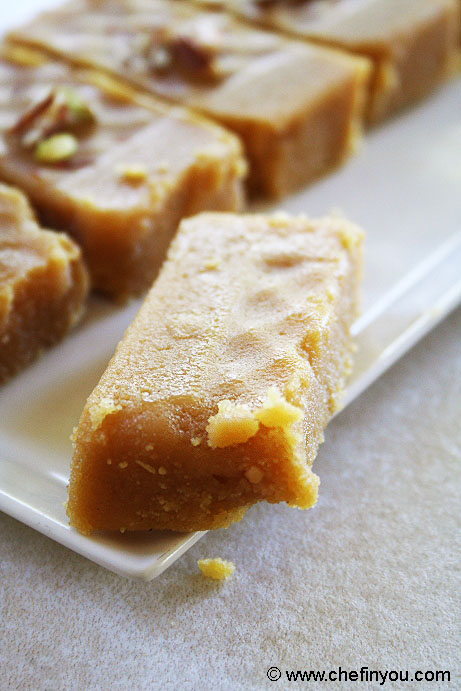
Enter OPOS©. Have you given up on my incessant OPOS mantra already? But wait...I am just getting started! And if you are still on the fence about OPOS, let my next few posts lure you into this addictive world of pressure cookers, whistles, clean kitchens, delicious foods, effortless cooking and cleaning! Coming back to this post today. We get Mysore Pak twins in the market - same yet different. One has porous texture while the other is "watch me disappear the second you put me in the mouth". We are looking at the latter today. But some keen chefinyou readers will tell me - but hey didn't you already post Amma's Soft Mysore Pa Recipe? Gosh! You people tear me up with happiness. But this is where my rant right at the beginning will make sense. That was my mom making the sweet, certainly not me. You know about sweet thumb? No? You know green thumb right? My mom is sweet thumbed while mine is probably black! She makes it look easy while my copycat attempts will make you stay away from kitchen! But armed with OPOS I am now thaumatin thumbed people! I can make sweets that look like these pictures. YES!
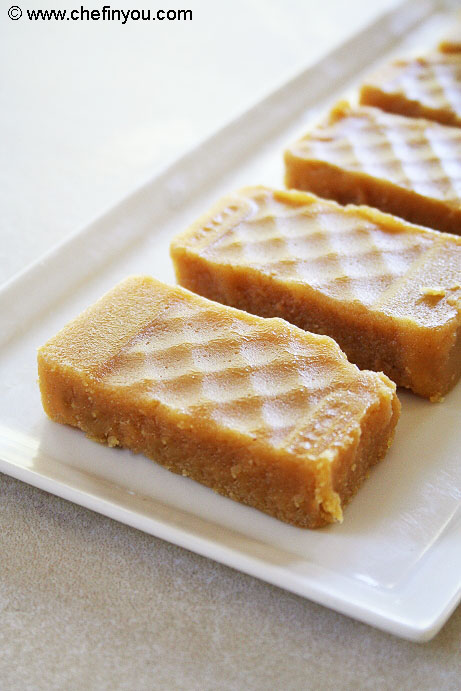
Can you see that slight ghee coated sheen on these delights? Does it speak to your senses? Does lack of teeth trouble you? Worry no more. These will speak to all your senses (and your neighbors!) and most importantly YOU will be making them on your own instead of calling Krishna Sweets ( replace with your favourite sweet shop) for your next delivery. If I looked like I was "high" when I was writing this - in a way, yes. It's cos I feel like I pulled a Usain bolt.. finally!
- Cook time:
- Prep time:
- Serves: Highly depends on one's sweet tooth!
- Yields: Eight rectangle (abt 4 inch) pieces
Ingredients
- 100 grams Besan (Kadalai maavu)
- 200 grams Sugar
- 125 ml + 1 tbsp Ghee divided
- 1/4 cup Water
- Ghee/oil for greasing
Method
1.
Sift the flour well. I find doing this step helps a great deal in avoiding lumps later.

2.
Any hard bits can be pressed into flour and used. Discard dirt or debris if any.

3.
Its extremely essential that you measure everything correctly. If your ghee is solid, melt and then measure the amount.

4.
In a skillet/kadai, warm the 125ml ghee. Don't overheat it - just slightly warm.

5.
Add the besan and stir to combine. Essentially we are making what the French call as roux.
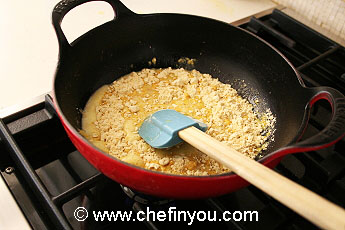
6.
This will be the trickiest part of today's recipe - making sure that you toast the flour well. The raw taste spoils the entire dish, so it pays to be a little overzealous in this step. Just don't burn it :) Traditionally the aroma dictates the "doneness". You start getting a toasty smell and the flour takes a deeper yellow from light yellow. I learned the difference during my beginner days by tasting the flour in the beginning and then after toasting. This process takes about 10-12 minutes on low flame. Don't forget to stir since it starts foaming otherwise. Another trick to check for doneness is to throw in a raw cashew along with the flour. When the cashew gets golden brown, your flour is about done as well. You can remove the cashew or use it, (or nibble it as a treat for a job well done!) - up to you. Set the roux aside.

7.
In a standardized (v. important) 2L PC, take the required sugar. I use organic blond sugar. It tends to taste a little less sweeter than regular sugar and that works perfect for our palate.

8.
Next add 1/4 cup water followed by 1 tbsp ghee. You can replace this ghee with cooking oil instead.

9.
and give it a whisk to slightly combine. Just 3-4 turns should do.

10.
Cook on HIGH until 5 whistles - around 4 minutes. The number of whistles can be from 4-6 with 4 whistles providing the soft fudge like consistency and 6 whistles for a firm consistency.

11.
May be because of the weather and/or different sugar that I use, 4 whistles gives me a very soft fudge that needs refrigeration to set - at times with almost halwa'ish texture. Hence I opt for either 5 or 6 whistles. The time taken for all of them must be within/around 4 minutes. More than 6 whistles will give you a sugar syrup with 1 string consistency - which is not a bad thing, but that won't make you the soft "melt-in-the-mouth" mysore pak that we are making today. So make sure you keep a timer nearby so that you don't extend the cooking time. If whistles are not coming, then you have a leaky/faulty cooker.

12.
The pressure valve pops up within couple of minutes,

13.
followed by the whistles. I gave it 6 whistles for this tutorial today which took me around 4 minutes.

14.
Switch off the heat and immediately release pressure using a spatula or any long ladle.

15.
This is how the sugar syrup looks like upon opening.

16.
Immediately, pour out the roux - the flour paste into the bubbling syrup.

17.
Give it a quick mix until well combined.

18.
Pour this to a well greased plate or pan. I used my regular 8" cake pan for this. A small/deep pan will give you thick slices similar to the ones sold at Krishna Sweets shops ands the likes. But any greased surface would work.

19.
Let it sit for few minutes until it starts firming up.

20.
Before it cools down completely, make slices. Its easier now when its warm than later. Then let it sit to cool down completely before removing these delicious golden slabs of heaven!

I inverted them to get those lovely patterns from my cake pan. And because I am a blogger, I had the obsessive need to decorate something that was already perfection; hence added some nuts and saffron on top. But really, you can totally bypass that over-enthusiasm :) These keep well at room temperature, although don't count on it lasting that long enough to worry about it getting stale!
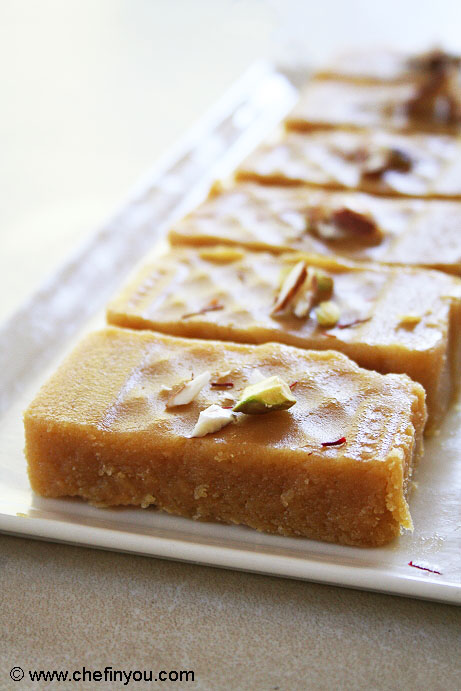
Filed Under these categories
- 99 Dasara
- 227 Desserts/Sweets
- 228 Diwali
- 29 Diwali Sweets
- 11 Easy Desserts and Sweets
- 447 Gluten Free
- 180 Indian Recipes
- 42 Indian Sweets
- 705 Kid Friendly
- 1 Kid Friendly Recipes
- 19 Kids Desserts
- 116 Krishna Jayanthi (Gokulashtami)
- 123 Navaratri Recipes
- 384 Nuts Free
- 7 OPOS Sweets & Desserts
- 18 OPOS- One Pot One Shot Recipes
- 13 Tamil New Year
- 18 Under 15 min - Desserts
Related Articles
- What is OPOS® Cooking?
- OPOS® – Frequently Asked Questions
- Measurement and Conversion Charts
- 7 Ways OPOS® Cooking Improved My Life
- Soaking and Sprouting – Planning my Weekly Menu
- Celebrating Diwali – An Easy 2 Hour Guide for the Busy Woman
- Thirukarthigai Festival – Why do we Celebrate Karthigai Deepam
- Ganesh Chavithi ( Vinayaka Chaturthi) Festival 2020 Recipes
- Diwali Festival Sweets and Snacks
- Pongal Festival 2012
- Indian Pongal Festival Recipes
Recipe Reference
Recipe by Ramki along with notes from OPOS School combined with my own experiments.
Related Posts
Mysore Pak (soft) By DK on Apr 19, 2011
Easy Rava Kesari (OPOS) By DK on Mar 9, 2018
Easy Pulikachal (OPOS©) By DK on Mar 26, 2018
OPOS Palak Paneer (Saag Paneer) By DK on May 1, 2020
OPOS Bottled Tadka (with Lentils) By DK on Mar 1, 2018
OPOS Rava Upma By DK on Mar 5, 2018
Leave a Reply
I love to hear from you! I read each and every comment, and will get
back as soon as I am able to.
9 Comments
By Farida Banu on Aug 24, 2020
Superb recipe
By Vasumathy on Jun 23, 2020
My first attempt Mysore Pak turned out to be bit gooey even after hardening..I missed it somewhere..probably the sugar syrup..
By Jayashree on May 28, 2020
Hi mam,
I'm a newbie to OPOS and trying to OPOS as many dishes as I could..after making sweets my heart started saying OPOS is a boon..
Your way of explaining mysorepa recipe is awesome(you speak my mind),I tried twice at home..it was a big hit..
My query is while scaling up,
For that if I go for 200grams of besan flour 400grams of Sugar
For SSH technique how much water should I pour?
Either the same 60 ml or 120ml?
Please guide me mam..
By Gayathri on Oct 29, 2019
Hi, very well explained. Thank you for the step by step photos. One quick question though. What change needs to be done to get the hard mysorepak (which is porous)?
By Kayal on Oct 28, 2019
I tried this one but the sugar and flour seems to be in separate layer, they didn't get combined.Sugar became like crystal.
By Sushant on Jan 1, 2019
This is one of my favorite sweet dish, the pic alone was enough to make me drool :)
By Cynthia on Sep 9, 2018
Very beautifully explained.
By Shanti Subramanian on Sep 8, 2018
Wonderful ..well explained...thank you. Just one query...how much water you added for this sugar qty?
Oops! Thanks for bringing the lapse to my notice. Its 1/4 cup water Shanthi. Have updated the post. Thank you once again :) --DK
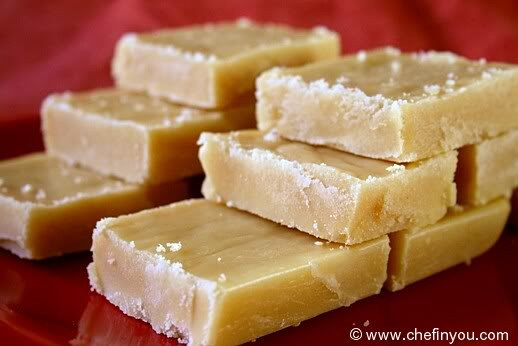





By Vidya Shivakumar on Sep 16, 2020
Then probably you can try going for 6 whistles next time around. As for this time, just keep it in the fridge. It will harden enough for you to be able to cut into slices. Hope this helps--DK